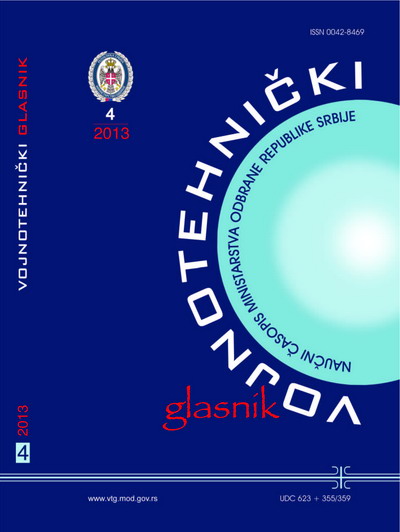Influence of technical and technological accidents caused by breakdowns, fires and explosions on human security
Abstract
In modern society, people are surrounded by many industrial facilities where technological accidents may occur due to breakdown, fire or explosion, endangering people residing in the immediate vicinity of the plant as well as those residing at a greater distance. In addition to the direct threat to humans, there are also indirect effects of technical and technological accidents which may be much more dangerous than direct effects. These indirect effects are manifested primarily from degraded and polluted environment, they are long term and often lead to illness and death of many people. The paper attempts to present all negative consequences of technical and technological accidents on the elements of a human security regarding the approach to the interpretation of human security in terms of sustainable development.
The concept of technical and technological accidents and human security
The accident is sudden emergence of major emission, fire or explosion as a result of unplanned events within certain industrial activities occurring within or outside the industry, including one or more chemicals. The assessment of the impact of technical and technological accidents on the state of human security is considered through the human security approach to the interpretation of the concept of sustainable development and the constitutive elements of human security.
The influence of technical and technological accidents on the state of human security
The influence of technical and technological accidents on human security can be seen through: deterioration of human health, food contamination, endangering macroeconomic stability in the region or the state as a whole, and violation of personal and collective security. Technical and technological accidents may lead to the destruction of the environment which may affect the balance of flora and fauna and can lead to the contamination of soil, air and water. The paper points out that the environmental risk assessment of environmental pollution due to technical and technological accidents as a potential threat or actual event is one of the main elements of solving problems of human and overall security.
Conclusion
The influence of technical and technological accidents on the environment is huge. It can be expressed in a range from slight imbalance in the ecosystem to serious ecosystem imbalance, depending on the intensity of technical and technological accidents and dangerous substances released during the accident. Technical and technological accidents are generators, or one of the biggest causes, of endangering human security. The implementation of measures to prevent technical and technological accidents increases the level of human security, which provides conditions for healthy environment and future generations.
References
Bakrač, S., Vuruna, M., Milanović M., 2010, Degradacija životne sredine - uticaj na ekološku bezbednost, Vojno delo, Jesen 2010, str. 314-328, preuzeto sa http://scindeks.ceon.rs/article.aspx?artid=0042-84261003314B0
Bakrač, S., Vuruna, M., Milanović, M., 2012, Metodologija upravljanja ekološkim rizikom i procene rizika, Vojnotehnički glasnik/Military Technical Courier, Vol. 60, No. 2, str. 296-305.
Čvorović, Z., 1999, Odgovor na hemijski akcident, Beograd, Zadužbina Andrejević.
Dulić, D., 2006, Ljudska bezbednost - zbornik tekstova, Beograd, Fond za otvoreno društvo, str. 1-1.
Đarmati, Š., Aleksić, Đ., 2004, Razorne sile.Beograd, Radnička štampa.
Đukanović, M., 1991, Ekološki izazov, Beograd, Elita.
Stevanović, B., et al, 2003, Enciklopedija, Životna sredina i održivi razvoj, Srpsko Sarajevo, Ecolibri i Zavod za udžbenike i nastavna sredstva.
Milašinović, R., Milašinović, S., 2004, Uvod u teorije konflikata, Beograd, Fakultet civilne odbrane.
Robinson, R., 1999, Global Problem and the Culture of Capitalism, London, Allyn & Bacon.
Mitić, M., Bakrač, S., 2010, Integracija procesa procene ekološkog rizika u proces evaluacije učinka zaštite životne sredine-metodološki pristup, Istraživanja i projektovanja za privredu, Beograd, broj 1 vol. 8, str. 22-26.
http://www.maharilikafilms.com/cyanide2/..., datum preuzimanja, 15.07.2012.
http://www.factosoline.nl/accidents/%205405/92188_ARSENIC%20HYDRIDE%20(ARSINE)/chemical-accidents-with-arsenic-hidride-(arsine), datum preuzimanja 01.08.2012.
http://www.un.org/en/documents/udhr, preuzimanja, 02.08.2012.
http://www.undp.org/en/reports/global/hdr1994/chapters, datum preuzimanja, 15.08.2012.
http://www.unep.org/Documents.Multilingual/., datum preuzimanja, 10.09.2012.
Proposed Creative Commons Copyright Notices
Proposed Policy for Military Technical Courier (Journals That Offer Open Access)
Authors who publish with this journal agree to the following terms:
Authors retain copyright and grant the journal right of first publication with the work simultaneously licensed under a Creative Commons Attribution License that allows others to share the work with an acknowledgement of the work's authorship and initial publication in this journal.
- Authors are able to enter into separate, additional contractual arrangements for the non-exclusive distribution of the journal's published version of the work (e.g., post it to an institutional repository or publish it in a book), with an acknowledgement of its initial publication in this journal.
- Authors are permitted and encouraged to post their work online (e.g., in institutional repositories or on their website) prior to and during the submission process, as it can lead to productive exchanges, as well as earlier and greater citation of published work (See The Effect of Open Access).

